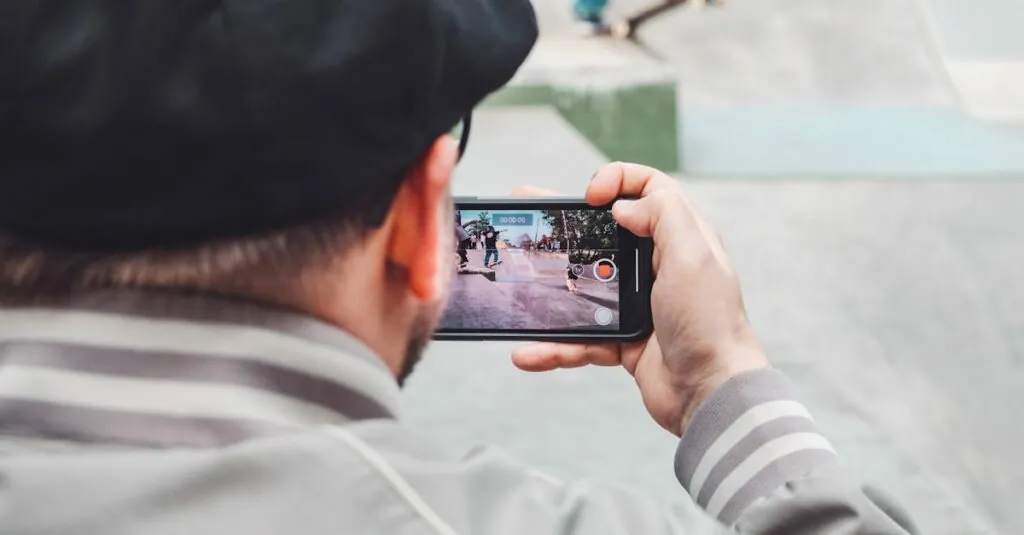Table of Contents
ToggleEver found yourself humming your favorite tune only to be greeted by the bland default ringtone on your iPhone? It’s time to break free from that monotony! Recording your own ringtone not only adds a personal touch but also ensures you’ll never miss an important call again—unless you’re busy dancing to your new jam, of course.
Overview of Ringtone Recording on iPhone
Recording a ringtone on an iPhone allows users to customize their device with a personal touch. It provides an opportunity to select a favorite song or sound clip, enhancing the overall phone experience. Various methods exist for creating a unique ringtone, including utilizing specific apps or software.
Users typically access GarageBand, an app designed for audio manipulation. GarageBand enables users to create ringtones from music tracks easily. By following a straightforward process, individuals can edit and export the finished product directly to their device.
Additionally, iTunes serves as another reliable tool for ringtone creation. Users can import audio files into iTunes, where they can trim and convert tracks into the appropriate format. This method requires connecting the iPhone to a computer, allowing for seamless transfer of the custom ringtone.
Some third-party apps also simplify ringtone recording and editing. Popular options include Ringtone Maker and Zedge, which offer user-friendly interfaces for crafting personalized sounds. These apps often include vast music libraries, contributing to easier access for users wanting to explore various sound choices.
Exploration of the recording process emphasizes essential steps like selecting the right audio file and ensuring it meets the length requirements (under 40 seconds). Applying these techniques enables users to enjoy a distinct ringtone that stands out among default options. Embracing such customization can lead to a more enjoyable iPhone experience while providing a distinct recognition for important calls.
Preparing Your iPhone for Ringtone Recording
Preparing an iPhone for recording a ringtone involves selecting the right tools and adjusting settings for optimal sound quality. Follow these steps to ensure a smooth recording process.
Required Apps
Install GarageBand from the App Store. This app provides a robust platform for creating custom ringtones. Explore Ringtone Maker or Zedge as well; both offer user-friendly interfaces and extensive music libraries. Choose any app that suits your preferences and needs. Users often find that GarageBand’s features enhance creativity during the recording process.
Necessary Settings
Adjust settings before starting the recording. Navigate to Settings, then Sounds & Haptics. Ensure that the volume is set to an adequate level for accurate recordings. Disable any background noise, notifications, or sounds that could interfere with the recording quality. Modify the record duration to 30 seconds or less, ensuring that it meets the iPhone’s ringtone specifications.
How to Record Ringtone on iPhone
Recording a ringtone on an iPhone can enhance personalization and sound recognition for incoming calls. Users can choose several methods, including GarageBand and various apps.
Using GarageBand
GarageBand provides a straightforward way to create ringtones. First, download and install the app from the App Store. After opening GarageBand, select an audio track to start your recording. Users can import music files or record directly from a microphone. Adjust the audio to ensure it lasts 30 seconds or less, as this is the maximum length supported by iPhones. After editing, export the audio as a ringtone file. Finally, sync the ringtone with iTunes for seamless integration into the iPhone’s ringtone settings.
Alternative Apps for Recording
Several third-party apps offer user-friendly alternatives for ringtone creation. Ringtone Maker allows users to create custom ringtones quickly by selecting specific sections of songs. Zedge provides an extensive library of sounds and enables users to edit audio in-app. These applications simplify the process and cater to various preferences. Users should ensure that the selected audio complies with the length requirements and is compatible with iPhone settings. Each method enables unique sounds for better personalization and call recognition.
Tips for Customizing Your Ringtone
Choose a specific sound that resonates personally. Users often find it helpful to select an audio file that reflects their style or taste in music. Popular platforms like GarageBand allow customization, enabling users to edit specific sections of songs or recordings.
Consider the context of your ringtone. Opting for a lively track can energize a dull moment, while a calming sound may suit professional settings. Users should ensure the length of the ringtone does not exceed 30 seconds to comply with iPhone limitations.
Explore sound effects in addition to music. Unique audio options, like nature sounds or voice recordings, can add a personal touch. GarageBand supports various audio formats, making customization straightforward.
Utilize various editing tools available in apps like Ringtone Maker and Zedge. Adjusting the volume, fade in, and fade out features can enhance the overall sound quality. Each app offers user-friendly interfaces for quick modifications.
Share your customized ringtones with friends. They might enjoy a unique sound and want to learn how to create their own. Providing a simple guide can help them discover personalized ringtone options that suit their preferences.
Regularly update ringtones to reflect changing tastes or seasons. Refreshing sounds regularly helps maintain interest and keeps the phone experience engaging. Following current trends or favorite genres can inspire fresh ideas for new ringtones.
Creating a personalized ringtone for an iPhone adds a unique touch to everyday phone interactions. By exploring different methods like GarageBand and various third-party apps, users can easily craft ringtones that reflect their personal style.
With the right tools and preparation, anyone can transform their favorite tunes or sounds into recognizable alerts. Regularly updating these ringtones not only keeps the experience fresh but also enhances the enjoyment of using the device. Embracing customization makes each call feel special and ensures important notifications stand out.




